rims SMART FORTWO COUPE 2010 Owners Manual
[x] Cancel search | Manufacturer: SMART, Model Year: 2010, Model line: FORTWO COUPE, Model: SMART FORTWO COUPE 2010Pages: 216, PDF Size: 9.7 MB
Page 11 of 216
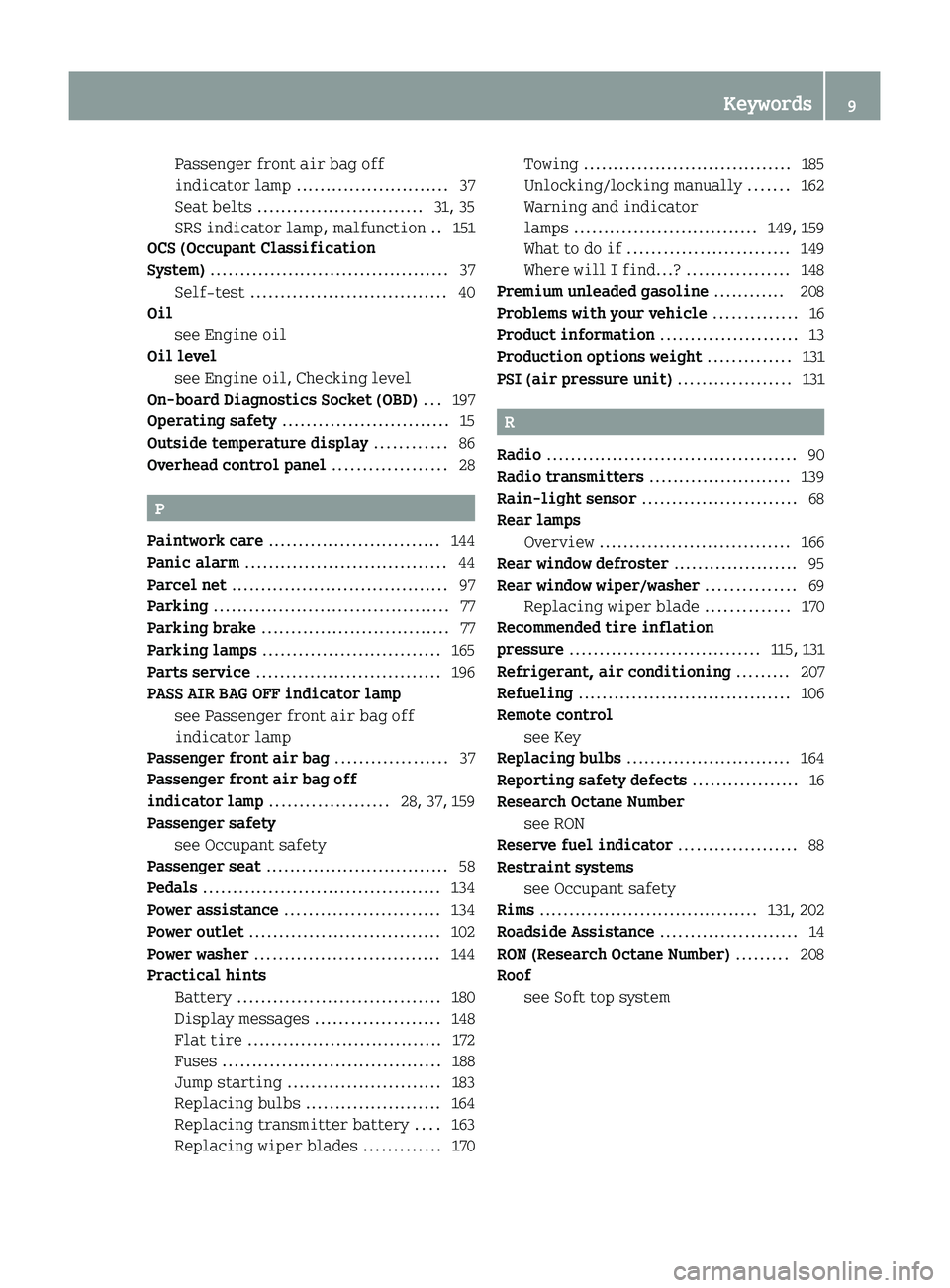
Passenger front air bag off
indicator lamp .......................... 37
Seat belts ............................ 31, 35
SRS indicator lamp, malfunction .. 151
OCS (Occupant Classification
System) ........................................ 37
Self-test ................................. 40
Oil
see Engine oil
Oil level
see Engine oil, Checking level
On-board Diagnostics Socket (OBD) ... 197
Operating safety ............................ 15
Outside temperature display ............ 86
Overhead control panel ................... 28
P
Paintwork care ............................. 144
Panic alarm .................................. 44
Parcel net ..................................... 97
Parking ........................................ 77
Parking brake ................................ 77
Parking lamps .............................. 165
Parts service ............................... 196
PASS AIR BAG OFF indicator lamp see Passenger front air bag off
indicator lamp
Passenger front air bag ................... 37
Passenger front air bag off
indicator lamp .................... 28, 37, 159
Passenger safety see Occupant safety
Passenger seat ............................... 58
Pedals ........................................ 134
Power assistance .......................... 134
Power outlet ................................ 102
Power washer ............................... 144
Practical hints
Battery .................................. 180
Display messages .....................148
Flat tire ................................. 172
Fuses ..................................... 188
Jump starting .......................... 183
Replacing bulbs ....................... 164
Replacing transmitter battery ....163
Replacing wiper blades .............170
Towing ................................... 185
Unlocking/locking manually .......162
Warning and indicator
lamps ............................... 149, 159
What to do if ........................... 149
Where will I find...? .................148
Premium unleaded gasoline ............ 208
Problems with your vehicle .............. 16
Product information ....................... 13
Production options weight .............. 131
PSI (air pressure unit) ................... 131
R
Radio .......................................... 90
Radio transmitters ........................ 139
Rain-light sensor .......................... 68
Rear lamps
Overview ................................ 166
Rear window defroster ..................... 95
Rear window wiper/washer ............... 69
Replacing wiper blade ..............170
Recommended tire inflation
pressure ................................ 115, 131
Refrigerant, air conditioning ......... 207
Refueling .................................... 106
Remote control see Key
Replacing bulbs ............................ 164
Reporting safety defects .................. 16
Research Octane Number see RON
Reserve fuel indicator .................... 88
Restraint systems see Occupant safety
Rims ..................................... 131, 202
Roadside Assistance ....................... 14
RON (Research Octane Number) ......... 208
Roof see Soft top system
Keywords9451_AKB; 3; 22, en-USd2ureepe,Version: 2.11.8.12009-07-27T09:36:34+02:00 - Seite 9
Page 12 of 216
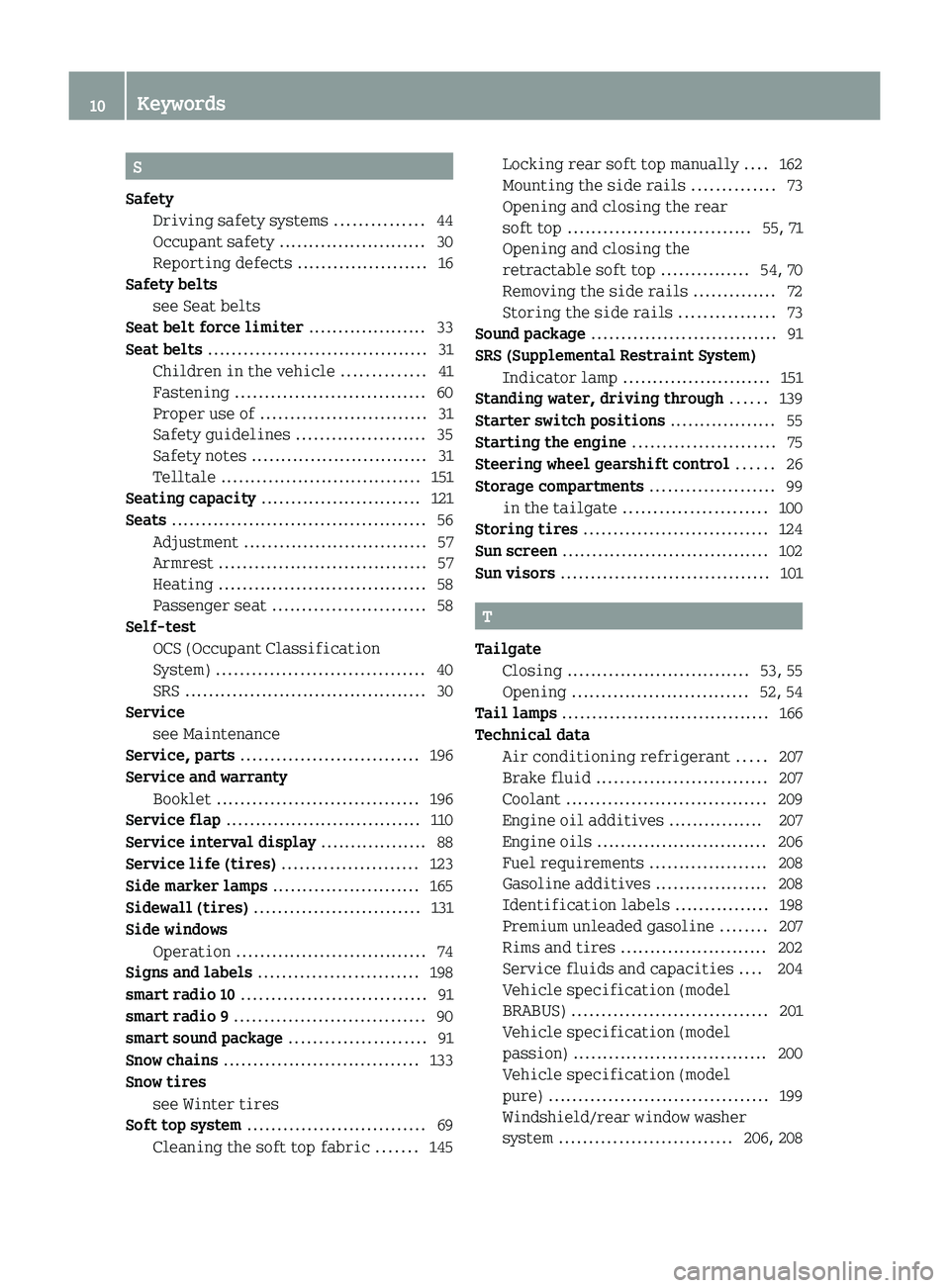
S
Safety
Driving safety systems ...............44
Occupant safety ......................... 30
Reporting defects ......................16
Safety belts
see Seat belts
Seat belt force limiter .................... 33
Seat belts ..................................... 31
Children in the vehicle ..............41
Fastening ................................ 60
Proper use of ............................ 31
Safety guidelines ......................35
Safety notes .............................. 31
Telltale .................................. 151
Seating capacity ........................... 121
Seats ........................................... 56
Adjustment ............................... 57
Armrest ................................... 57
Heating ................................... 58
Passenger seat .......................... 58
Self-test
OCS (Occupant Classification
System) ................................... 40
SRS ......................................... 30
Service
see Maintenance
Service, parts .............................. 196
Service and warranty
Booklet .................................. 196
Service flap ................................. 110
Service interval display .................. 88
Service life (tires) ....................... 123
Side marker lamps ......................... 165
Sidewall (tires) ............................ 131
Side windows
Operation ................................ 74
Signs and labels ........................... 198
smart radio 10 ............................... 91
smart radio 9 ................................ 90
smart sound package ....................... 91
Snow chains ................................. 133
Snow tires see Winter tires
Soft top system .............................. 69
Cleaning the soft top fabric .......145Locking rear soft top manually ....162
Mounting the side rails ..............73
Opening and closing the rear
soft top ............................... 55, 71
Opening and closing the
retractable soft top ...............54, 70
Removing the side rails ..............72
Storing the side rails ................73
Sound package ............................... 91
SRS (Supplemental Restraint System)
Indicator lamp ......................... 151
Standing water, driving through ...... 139
Starter switch positions .................. 55
Starting the engine ........................ 75
Steering wheel gearshift control ...... 26
Storage compartments ..................... 99
in the tailgate ........................ 100
Storing tires ............................... 124
Sun screen ................................... 102
Sun visors ................................... 101
T
Tailgate
Closing ............................... 53, 55
Opening .............................. 52, 54
Tail lamps ................................... 166
Technical data
Air conditioning refrigerant .....207
Brake fluid ............................. 207
Coolant .................................. 209
Engine oil additives ................ 207
Engine oils ............................. 206
Fuel requirements ....................208
Gasoline additives ...................208
Identification labels ................198
Premium unleaded gasoline ........207
Rims and tires ......................... 202
Service fluids and capacities ....204
Vehicle specification (model
BRABUS) ................................. 201
Vehicle specification (model
passion) ................................. 200
Vehicle specification (model
pure) ..................................... 199
Windshield/rear window washer
system ............................. 206, 208
10Keywords451_AKB; 3; 22, en-USd2ureepe,Version: 2.11.8.12009-07-27T09:36:34+02:00 - Seite 10
Page 13 of 216
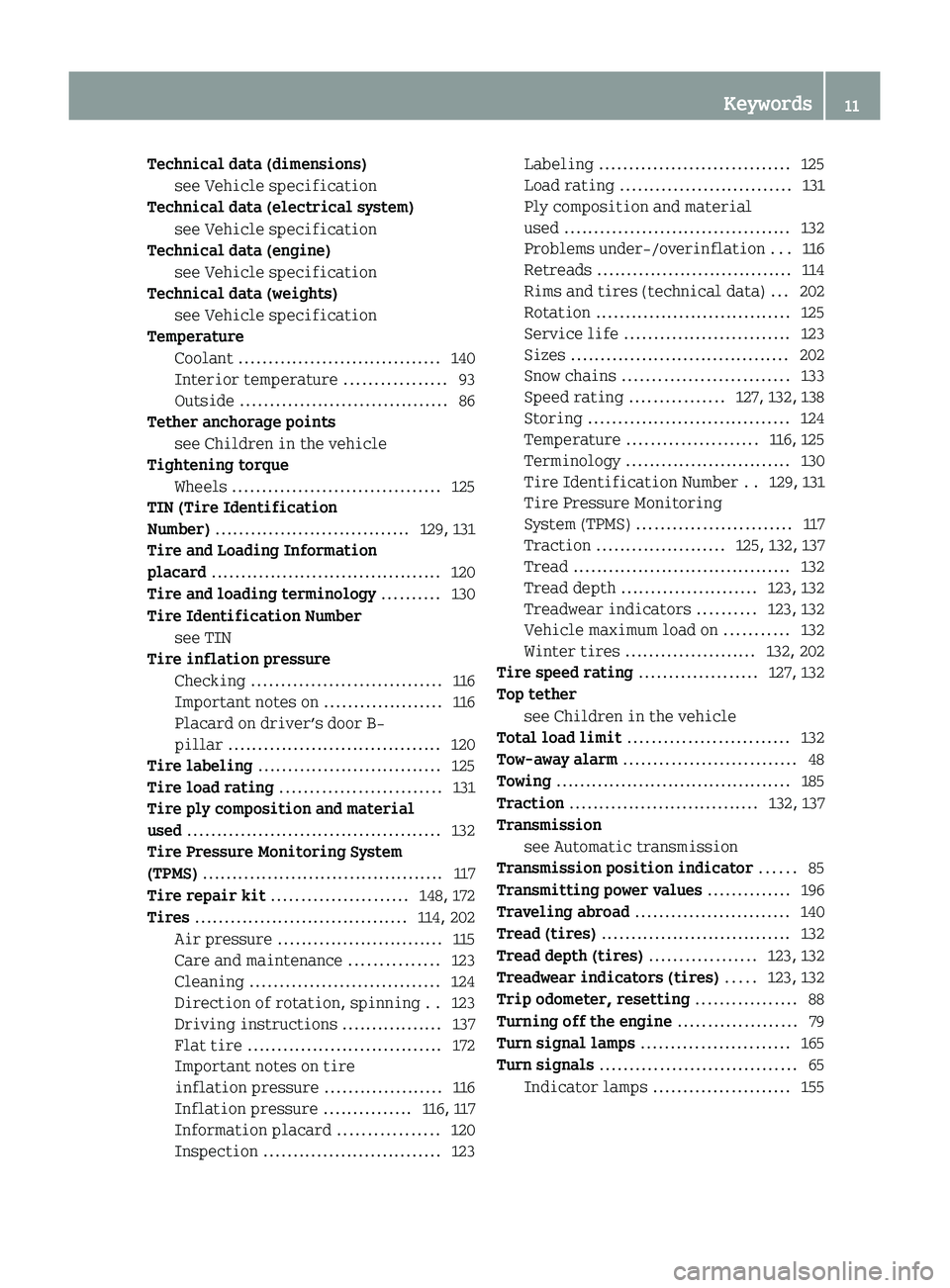
Technical data (dimensions)see Vehicle specification
Technical data (electrical system)
see Vehicle specification
Technical data (engine)
see Vehicle specification
Technical data (weights)
see Vehicle specification
Temperature
Coolant .................................. 140
Interior temperature .................93
Outside ................................... 86
Tether anchorage points
see Children in the vehicle
Tightening torque
Wheels ................................... 125
TIN (Tire Identification
Number) ................................. 129, 131
Tire and Loading Information
placard ....................................... 120
Tire and loading terminology .......... 130
Tire Identification Number see TIN
Tire inflation pressure
Checking ................................ 116
Important notes on ....................116
Placard on driver’s door B-
pillar .................................... 120
Tire labeling ............................... 125
Tire load rating ........................... 131
Tire ply composition and material
used ........................................... 132
Tire Pressure Monitoring System
(TPMS) ......................................... 117
Tire repair kit ....................... 148, 172
Tires .................................... 114, 202
Air pressure ............................ 115
Care and maintenance ...............123
Cleaning ................................ 124
Direction of rotation, spinning ..123
Driving instructions ................. 137
Flat tire ................................. 172
Important notes on tire
inflation pressure ....................116
Inflation pressure ...............116, 117
Information placard .................120
Inspection .............................. 123Labeling ................................ 125
Load rating ............................. 131
Ply composition and material
used ...................................... 132
Problems under-/overinflation ...116
Retreads ................................. 114
Rims and tires (technical data) ...202
Rotation ................................. 125
Service life ............................ 123
Sizes ..................................... 202
Snow chains ............................ 133
Speed rating ................ 127, 132, 138
Storing .................................. 124
Temperature ...................... 116, 125
Terminology ............................ 130
Tire Identification Number ..129, 131
Tire Pressure Monitoring
System (TPMS) .......................... 117
Traction ...................... 125, 132, 137
Tread ..................................... 132
Tread depth ....................... 123, 132
Treadwear indicators ..........123, 132
Vehicle maximum load on ...........132
Winter tires ...................... 132, 202
Tire speed rating .................... 127, 132
Top tether see Children in the vehicle
Total load limit ........................... 132
Tow-away alarm ............................. 48
Towing ........................................ 185
Traction ................................ 132, 137
Transmission see Automatic transmission
Transmission position indicator ...... 85
Transmitting power values .............. 196
Traveling abroad .......................... 140
Tread (tires) ................................ 132
Tread depth (tires) .................. 123, 132
Treadwear indicators (tires) ..... 123, 132
Trip odometer, resetting ................. 88
Turning off the engine .................... 79
Turn signal lamps ......................... 165
Turn signals ................................. 65
Indicator lamps ....................... 155Keywords11451_AKB; 3; 22, en-USd2ureepe,Version: 2.11.8.12009-07-27T09:36:34+02:00 - Seite 11
Page 116 of 216
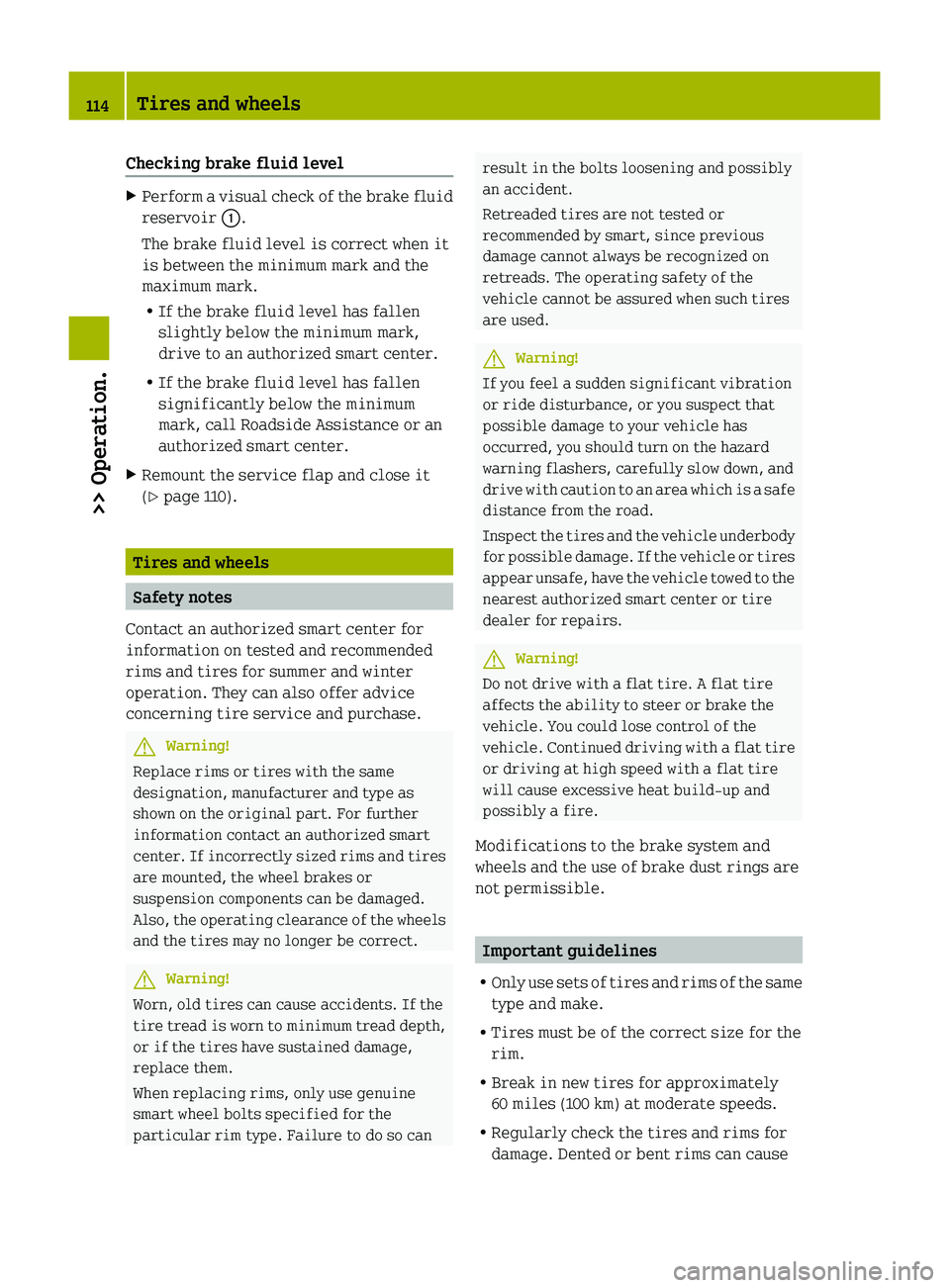
Checking brake fluid levelXPerform a visual check of the brake fluid
reservoir 0046.
The brake fluid level is correct when it
is between the minimum mark and the
maximum mark.
R If the brake fluid level has fallen
slightly below the minimum mark,
drive to an authorized smart center.
R If the brake fluid level has fallen
significantly below the minimum
mark, call Roadside Assistance or an
authorized smart center.XRemount the service flap and close it
( Y page 110).
Tires and wheels
Safety notes
Contact an authorized smart center for
information on tested and recommended
rims and tires for summer and winter
operation. They can also offer advice
concerning tire service and purchase.
GWarning!
Replace rims or tires with the same
designation, manufacturer and type as
shown on the original part. For further
information contact an authorized smart
center. If incorrectly sized rims and tires
are mounted, the wheel brakes or
suspension components can be damaged.
Also, the operating clearance of the wheels
and the tires may no longer be correct.
GWarning!
Worn, old tires can cause accidents. If the
tire tread is worn to minimum tread depth,
or if the tires have sustained damage,
replace them.
When replacing rims, only use genuine
smart wheel bolts specified for the
particular rim type. Failure to do so can
result in the bolts loosening and possibly
an accident.
Retreaded tires are not tested or
recommended by smart, since previous
damage cannot always be recognized on
retreads. The operating safety of the
vehicle cannot be assured when such tires
are used.GWarning!
If you feel a sudden significant vibration
or ride disturbance, or you suspect that
possible damage to your vehicle has
occurred, you should turn on the hazard
warning flashers, carefully slow down, and
drive with caution to an area which is a safe
distance from the road.
Inspect the tires and the vehicle underbody
for possible damage. If the vehicle or tires
appear unsafe, have the vehicle towed to the
nearest authorized smart center or tire
dealer for repairs.
GWarning!
Do not drive with a flat tire. A flat tire
affects the ability to steer or brake the
vehicle. You could lose control of the
vehicle. Continued driving with a flat tire
or driving at high speed with a flat tire
will cause excessive heat build-up and
possibly a fire.
Modifications to the brake system and
wheels and the use of brake dust rings are
not permissible.
Important guidelines
R Only use sets of tires and rims of the same
type and make.
R Tires must be of the correct size for the
rim.
R Break in new tires for approximately
60 miles (100 km) at moderate speeds.
R Regularly check the tires and rims for
damage. Dented or bent rims can cause
114Tires and wheels>> Operation.
451_AKB; 3; 22, en-USd2ureepe,Version: 2.11.8.12009-07-27T09:36:34+02:00 - Seite 114
Page 127 of 216
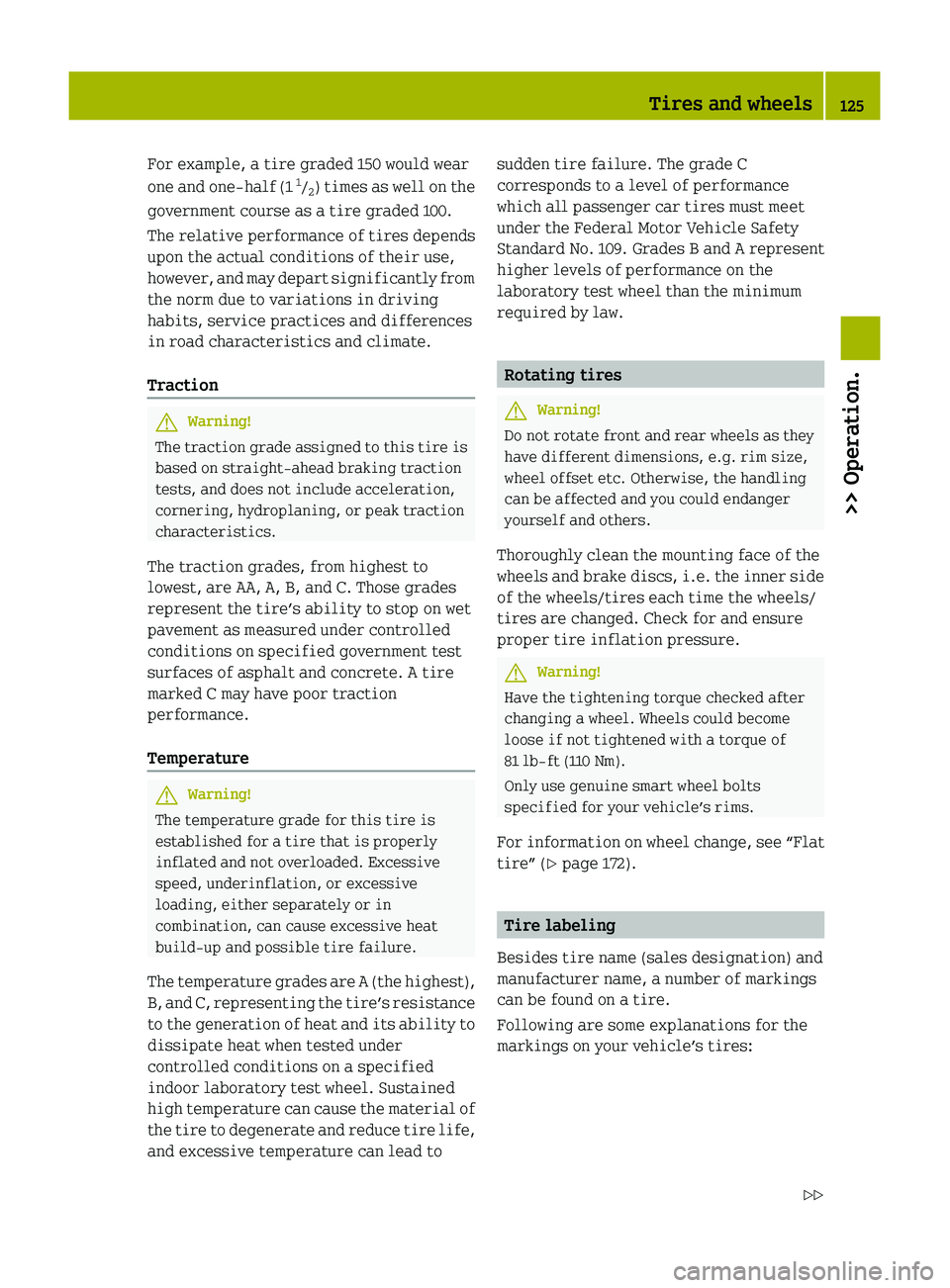
For example, a tire graded 150 would wear
one and one-half (1 1
/ 2) times as well on the
government course as a tire graded 100.
The relative performance of tires depends
upon the actual conditions of their use,
however, and may depart significantly from
the norm due to variations in driving
habits, service practices and differences
in road characteristics and climate.
Traction GWarning!
The traction grade assigned to this tire is
based on straight-ahead braking traction
tests, and does not include acceleration,
cornering, hydroplaning, or peak traction
characteristics.
The traction grades, from highest to
lowest, are AA, A, B, and C. Those grades
represent the tire’s ability to stop on wet
pavement as measured under controlled
conditions on specified government test
surfaces of asphalt and concrete. A tire
marked C may have poor traction
performance.
Temperature
GWarning!
The temperature grade for this tire is
established for a tire that is properly
inflated and not overloaded. Excessive
speed, underinflation, or excessive
loading, either separately or in
combination, can cause excessive heat
build-up and possible tire failure.
The temperature grades are A (the highest),
B, and C, representing the tire’s resistance
to the generation of heat and its ability to
dissipate heat when tested under
controlled conditions on a specified
indoor laboratory test wheel. Sustained
high temperature can cause the material of
the tire to degenerate and reduce tire life,
and excessive temperature can lead to
sudden tire failure. The grade C
corresponds to a level of performance
which all passenger car tires must meet
under the Federal Motor Vehicle Safety
Standard No. 109. Grades B and A represent
higher levels of performance on the
laboratory test wheel than the minimum
required by law.
Rotating tires
GWarning!
Do not rotate front and rear wheels as they
have different dimensions, e.g. rim size,
wheel offset etc. Otherwise, the handling
can be affected and you could endanger
yourself and others.
Thoroughly clean the mounting face of the
wheels and brake discs, i.e. the inner side
of the wheels/tires each time the wheels/
tires are changed. Check for and ensure
proper tire inflation pressure.
GWarning!
Have the tightening torque checked after
changing a wheel. Wheels could become
loose if not tightened with a torque of
81 lb‑ft (110 Nm).
Only use genuine smart wheel bolts
specified for your vehicle’s rims.
For information on wheel change, see “Flat
tire” ( Y page 172).
Tire labeling
Besides tire name (sales designation) and
manufacturer name, a number of markings
can be found on a tire.
Following are some explanations for the
markings on your vehicle’s tires:
Tires and wheels125>> Operation.451_AKB; 3; 22, en-USd2ureepe,Version: 2.11.8.12009-07-27T09:36:34+02:00 - Seite 125Z
Page 128 of 216
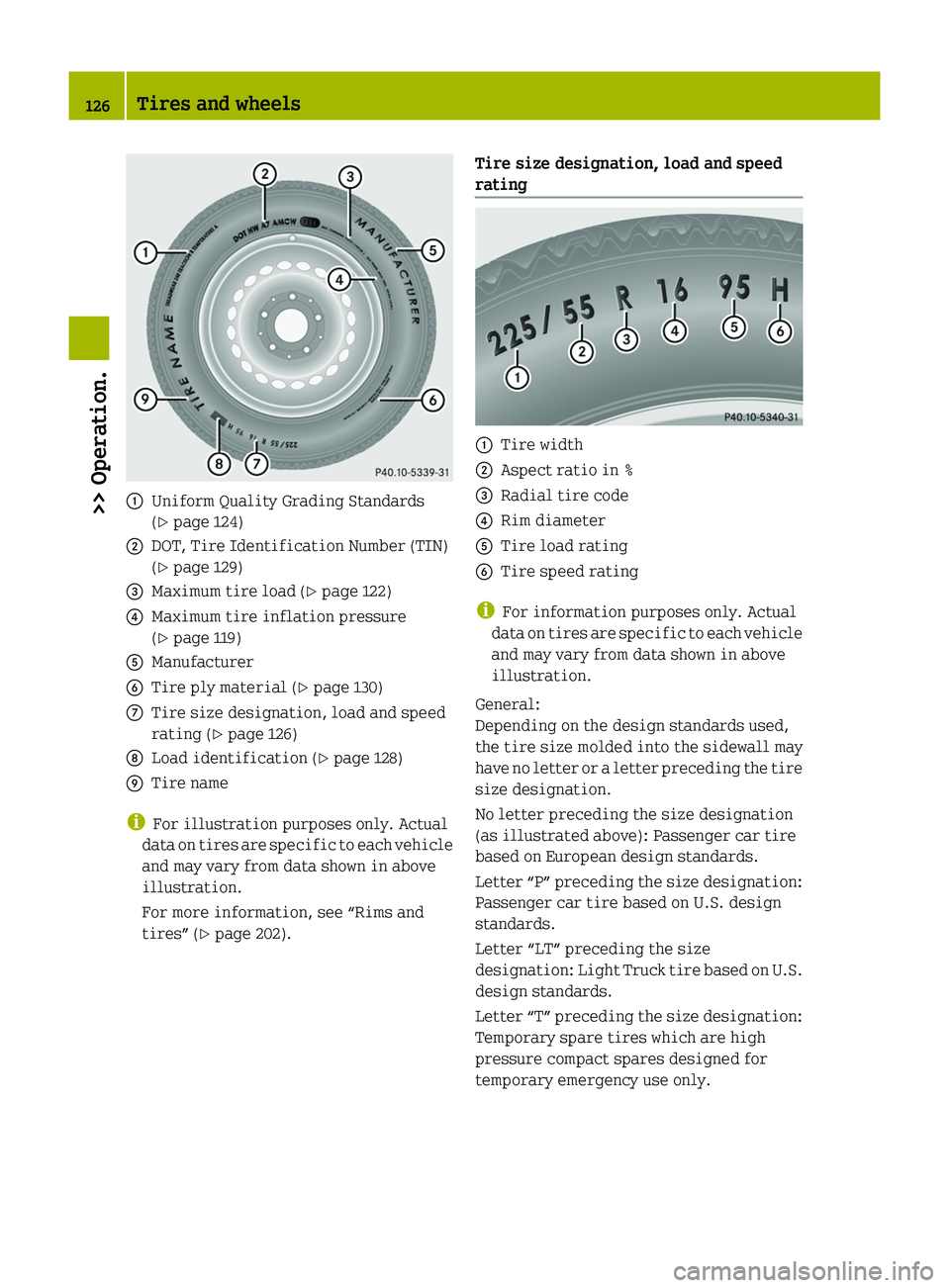
0046Uniform Quality Grading Standards
( Y page 124)0047DOT, Tire Identification Number (TIN)
( Y page 129)008AMaximum tire load ( Y page 122)0088Maximum tire inflation pressure
( Y page 119)0086Manufacturer0087Tire ply material ( Y page 130)006ETire size designation, load and speed
rating ( Y page 126)006FLoad identification ( Y page 128)0070Tire name
i
For illustration purposes only. Actual
data on tires are specific to each vehicle
and may vary from data shown in above
illustration.
For more information, see “Rims and
tires” ( Y page 202).
Tire size designation, load and speed
rating0046Tire width0047Aspect ratio in %008ARadial tire code0088Rim diameter0086Tire load rating0087Tire speed rating
i For information purposes only. Actual
data on tires are specific to each vehicle
and may vary from data shown in above
illustration.
General:
Depending on the design standards used,
the tire size molded into the sidewall may
have no letter or a letter preceding the tire
size designation.
No letter preceding the size designation
(as illustrated above): Passenger car tire
based on European design standards.
Letter “P” preceding the size designation:
Passenger car tire based on U.S. design
standards.
Letter “LT” preceding the size
designation: Light Truck tire based on U.S.
design standards.
Letter “T” preceding the size designation:
Temporary spare tires which are high
pressure compact spares designed for
temporary emergency use only.
126Tires and wheels>> Operation.
451_AKB; 3; 22, en-USd2ureepe,Version: 2.11.8.12009-07-27T09:36:34+02:00 - Seite 126
Page 129 of 216

Tire width
Tire width 0046 indicates the nominal tire
width in mm.
Aspect ratio
Aspect ratio 0047 is the dimensional
relationship between tire section height
and section width and is expressed as a
percentage. The aspect ratio is arrived at
by dividing section height by section
width.
Tire code
Tire code 008A indicates the tire
construction type. The “R” stands for radial
tire type. Letter “D” means diagonal or
bias ply construction; letter “B” means
belted-bias ply construction.
At the tire manufacturer’s option, any tire
with a speed capability above 149 mph
(240 km/h) can include a “ZR” in the size
designation (for example: 245/40 ZR 18).
For additional information, see “Tire
speed rating” ( Y page 127).
Rim diameter
Rim diameter 0088 is the diameter of the
bead seat, not the diameter of the rim edge.
Rim diameter is indicated in inches (in).
Tire load ratingGWarning!
The tire load rating must always be at least
half of the GAWR of your vehicle. Otherwise,
tire failure may result and cause an
accident and/or serious personal injury to
you or others.
Always replace rims and tires with the same
designation, manufacturer and type as
shown on the original part.
GWarning!
Do not overload the tires by exceeding the
specified load limit as indicated on the
Tire and Loading Information placard on
the driver’s door B‑pillar. Overloading the
tires can overheat them, possibly causing
a blowout. Overloading the tires can also
result in handling or steering problems, or
brake failure.
Tire load rating 0086 is a numerical code
associated with the maximum load a tire
can support.
For example, a load rating of 91
corresponds to a maximum load of 1 356 lbs
(615 kg) the tire is designed to support.
See also “Maximum tire load” ( Y page 122)
where the maximum load associated with
the load index is indicated in kilograms
and lbs.
For additional information on tire load
rating, see “Load identification”
( Y page 128).
Tire speed rating GWarning!
Even when permitted by law, never operate
a vehicle at speeds greater than the
maximum speed rating of the tires.
Exceeding the maximum speed for which
tires are rated can lead to sudden tire
failure, causing loss of vehicle control and
possibly resulting in an accident and/or
personal injury and possible death, for you
and for others.
Regardless of the tire speed rating, local
speed limits should be obeyed. Use prudent
driving speeds appropriate to prevailing
conditions.
Tire speed rating 0087 indicates the
approved maximum speed for the tire.
Summer tires
IndexSpeed ratingQup to 100 mph (160 km/h)Rup to 106 mph (170 km/h)Sup to 112 mph (180 km/h)Tup to 118 mph (190 km/h)Tires and wheels127>> Operation.451_AKB; 3; 22, en-USd2ureepe,Version: 2.11.8.12009-07-27T09:36:34+02:00 - Seite 127Z
Page 197 of 216
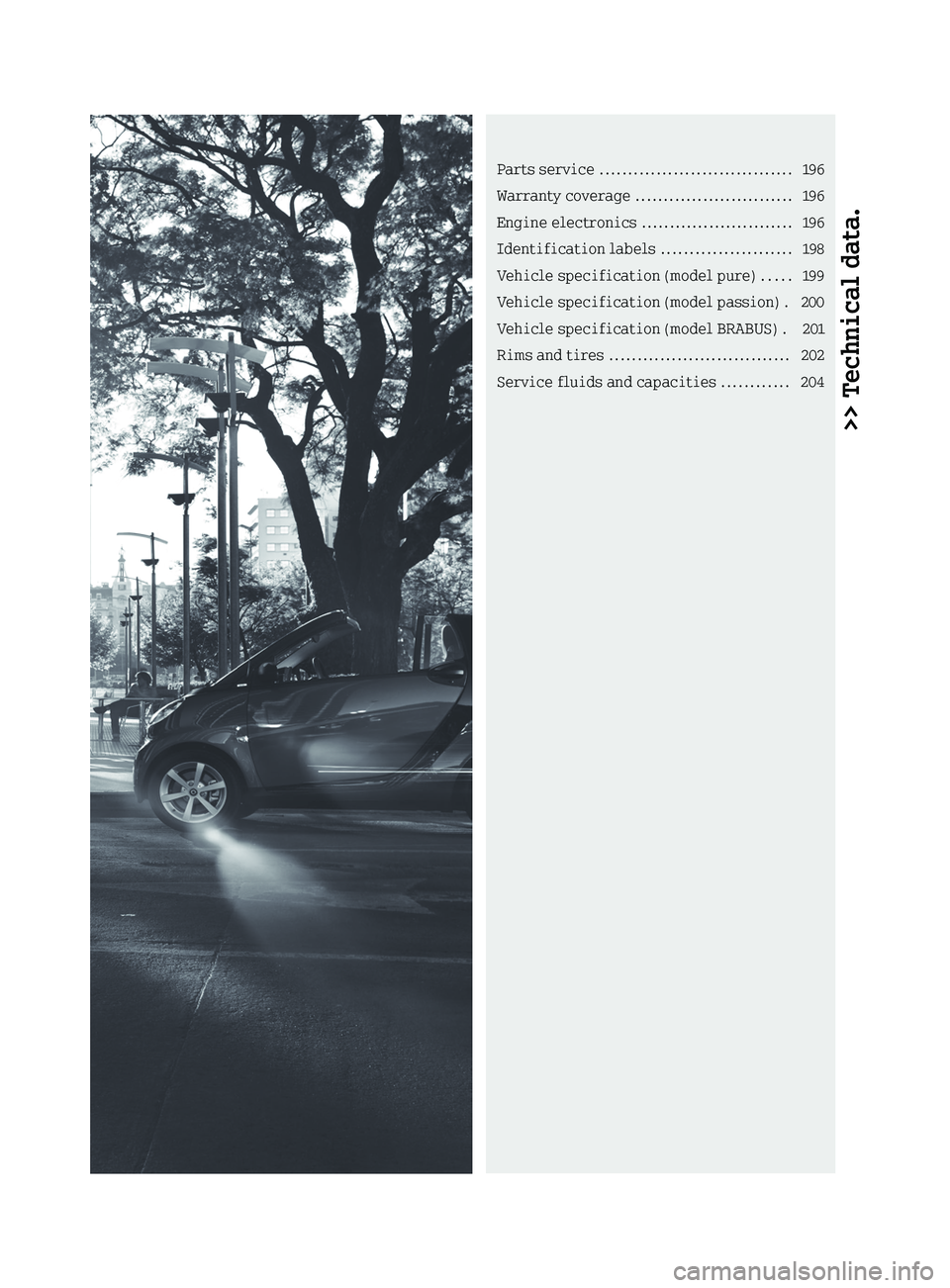
>> Technical data.Parts service .................................. 196
Warranty coverage ............................ 196
Engine electronics ........................... 196
Identification labels .......................198
Vehicle specification (model pure) .....199
Vehicle specification (model passion) . 200
Vehicle specification (model BRABUS) . 201
Rims and tires ................................ 202
Service fluids and capacities ............204451_AKB; 3; 22, en-USd2ureepe,Version: 2.11.8.12009-07-27T09:36:34+02:00 - Seite 195
Page 204 of 216
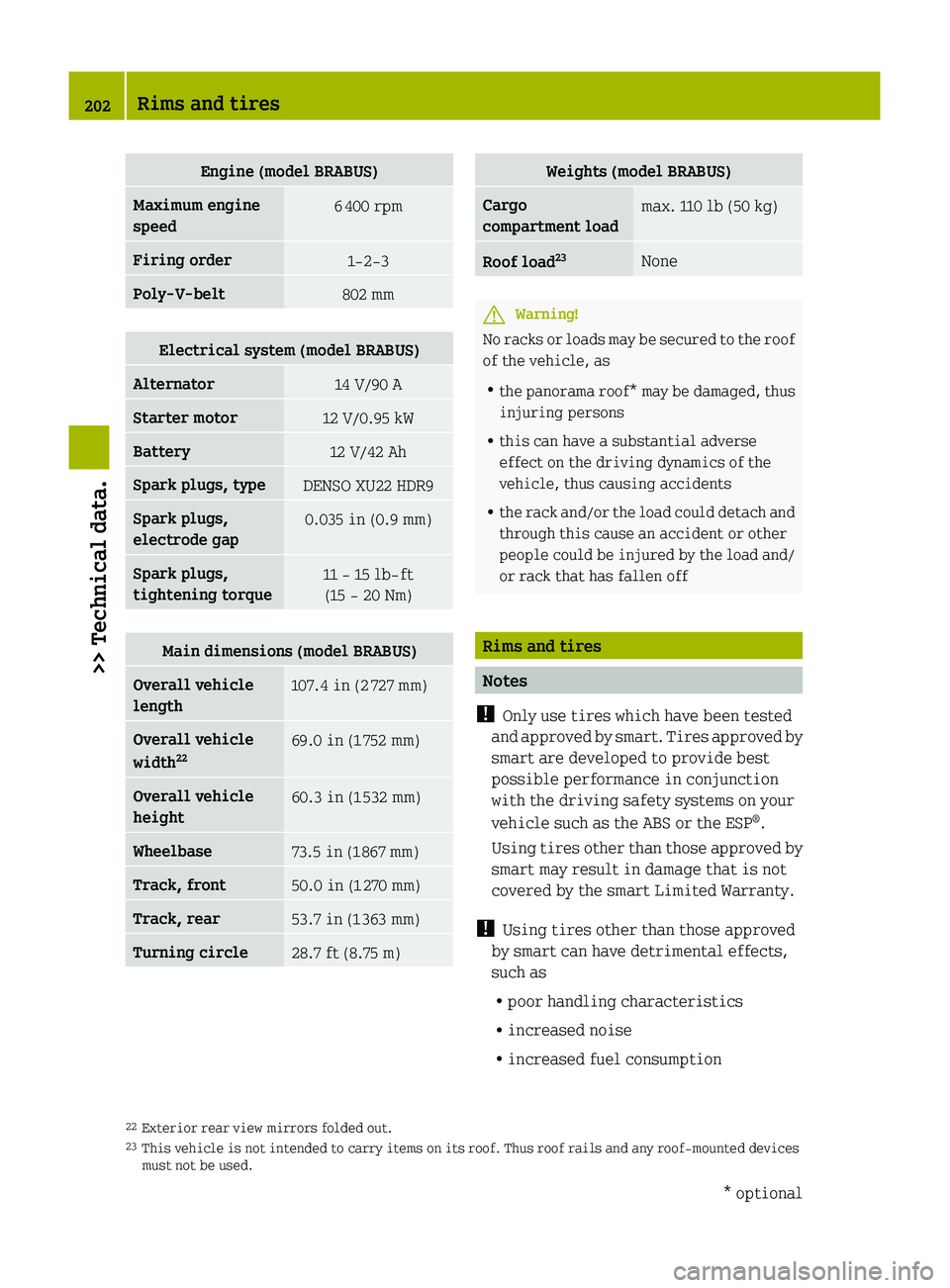
Engine (model BRABUS)Maximum engine
speed6 400 rpmFiring order1-2-3Poly‑V‑belt802 mmElectrical system (model BRABUS)Alternator14 V/90 AStarter motor12 V/0.95 kWBattery12 V/42 AhSpark plugs, typeDENSO XU22 HDR9Spark plugs,
electrode gap0.035 in (0.9 mm)Spark plugs,
tightening torque11 - 15 lb-ft (15 - 20 Nm)Main dimensions (model BRABUS)Overall vehicle
length107.4 in (2 727 mm)Overall vehicle
width 2269.0 in (1
752 mm)Overall vehicle
height60.3 in (1 532 mm)Wheelbase73.5 in (1 867 mm)Track, front50.0 in (1 270 mm)Track, rear53.7 in (1 363 mm)Turning circle28.7 ft (8.75 m)Weights (model BRABUS)Cargo
compartment loadmax. 110 lb (50 kg)Roof load 23NoneGWarning!
No racks or loads may be secured to the roof
of the vehicle, as
R the panorama roof* may be damaged, thus
injuring persons
R this can have a substantial adverse
effect on the driving dynamics of the
vehicle, thus causing accidents
R the rack and/or the load could detach and
through this cause an accident or other
people could be injured by the load and/
or rack that has fallen off
Rims and tires
Notes
! Only use tires which have been tested
and approved by smart. Tires approved by
smart are developed to provide best
possible performance in conjunction
with the driving safety systems on your
vehicle such as the ABS or the ESP ®
.
Using tires other than those approved by
smart may result in damage that is not
covered by the smart Limited Warranty.
! Using tires other than those approved
by smart can have detrimental effects,
such as
R poor handling characteristics
R increased noise
R increased fuel consumption
22Exterior rear view mirrors folded out.
23 This vehicle is not intended to carry items on its roof. Thus roof rails and any roof-mounted devices
must not be used.202Rims and tires>> Technical data.* optional451_AKB; 3; 22, en-USd2ureepe,Version: 2.11.8.12009-07-27T09:36:34+02:00 - Seite 202
Page 205 of 216
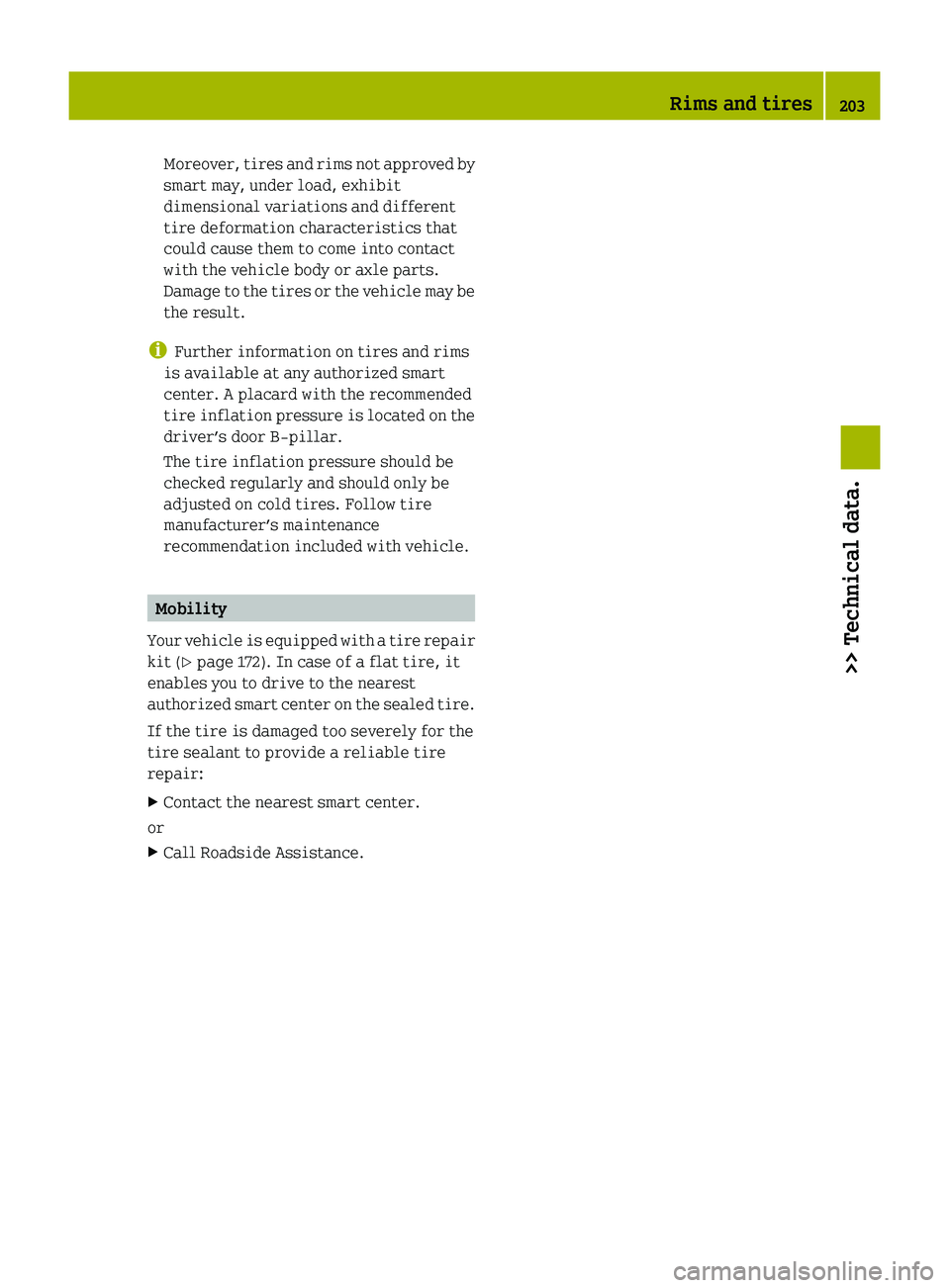
Moreover, tires and rims not approved by
smart may, under load, exhibit
dimensional variations and different
tire deformation characteristics that
could cause them to come into contact
with the vehicle body or axle parts.
Damage to the tires or the vehicle may be
the result.
i Further information on tires and rims
is available at any authorized smart
center. A placard with the recommended
tire inflation pressure is located on the
driver’s door B‑pillar.
The tire inflation pressure should be
checked regularly and should only be
adjusted on cold tires. Follow tire
manufacturer’s maintenance
recommendation included with vehicle.
Mobility
Your vehicle is equipped with a tire repair
kit ( Y page 172). In case of a flat tire, it
enables you to drive to the nearest
authorized smart center on the sealed tire.
If the tire is damaged too severely for the
tire sealant to provide a reliable tire
repair:
XContact the nearest smart center.
or
XCall Roadside Assistance.Rims and tires203>> Technical data.451_AKB; 3; 22, en-USd2ureepe,Version: 2.11.8.12009-07-27T09:36:34+02:00 - Seite 203Z